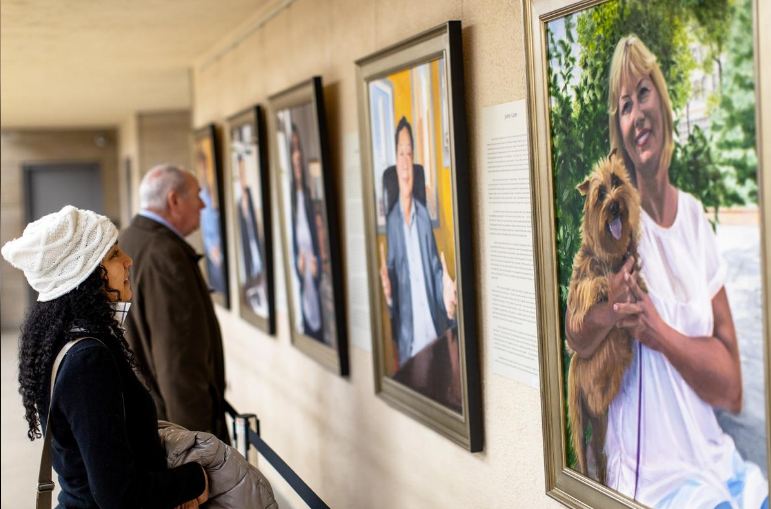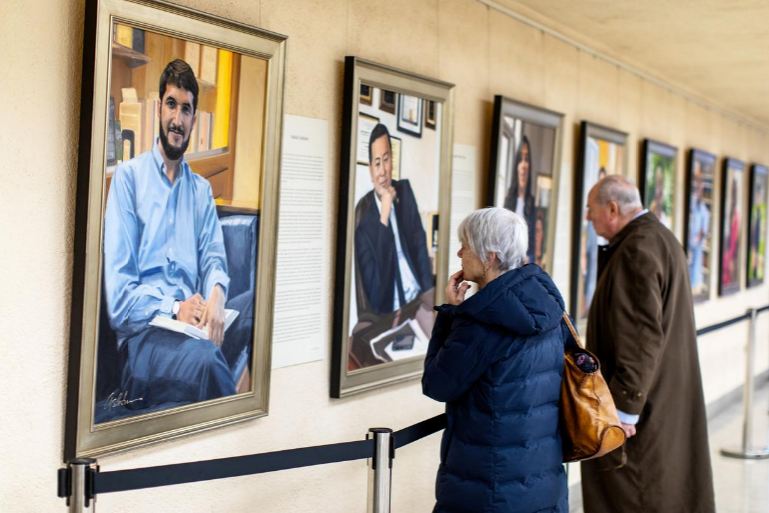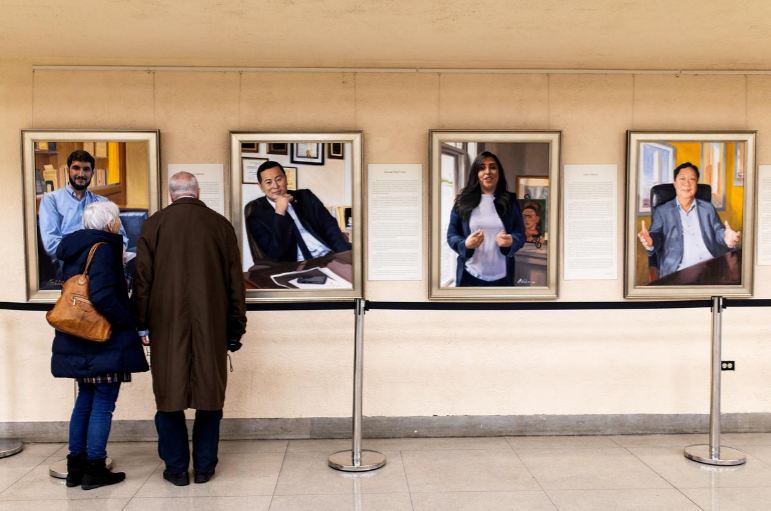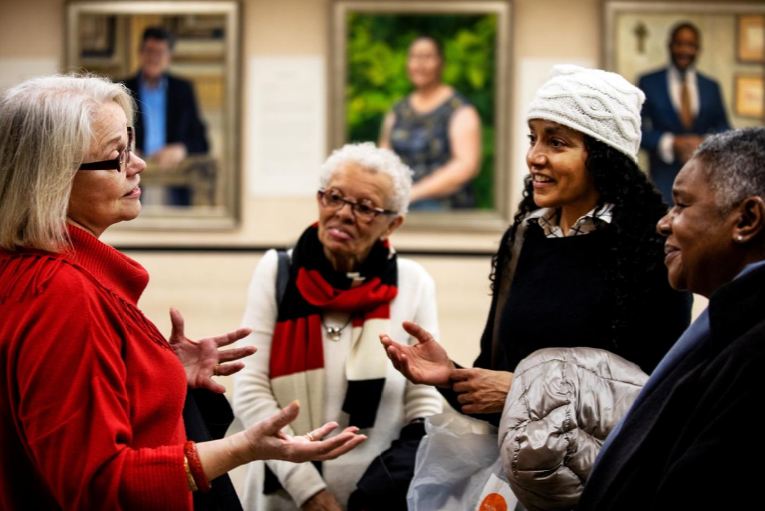Immigrant portraits in New York art show face down Trump
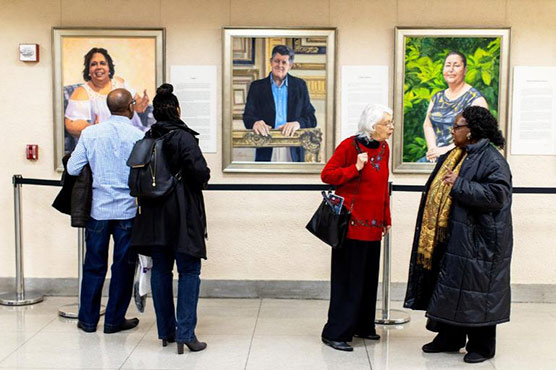
Visitors at Betsy Ashton's exhibition, "Portraits of Immigrants: Unknown Faces, Untold Stories", U.S
NEW YORK (Reuters) - Immigrant faces captured in life-sized portraits by artist Betsy Ashton look the viewer straight in the eye, as if eager to tell their stories of leaving home to brave new struggles in a strange land.
Ashton said she created the oil paintings to counter what she calls a false political narrative spun by the Trump administration.
“I simply decided it was time to balance the story, time to try to counter this inflammatory rage that’s being whipped up against a group of people that don’t deserve it,” Ashton said.
Her “Portraits of Immigrants” are on display through Easter at Manhattan’s Riverside Church, about 10 miles up the Hudson River from Ellis Island, where 12 million newcomers landed from 1892 to 1954. The Statue of Liberty towers over the island, asking the world in a plaque to “Give me your tired, your poor, your huddled masses yearning to breathe free.”
The portraits include teachers, entrepreneurs, a nurse, housekeeper, actor, politician and barista from Asia, Africa, Latin America, the Caribbean and Europe. They are newcomers and long-timers. Some are U.S. citizens, others have proper documents, one does not.
STRUGGLING TO FIT IN TO A NEW CULTURE
Their stories, which Ashton, a former CBS News correspondent, wrote and posted next to each portrait, tell of struggling to fit in to a new culture and learning a new language for the promise of a better life.
“The collective portrayal of the immigrant experience is what’s compelling, not just one individual story,” said Ron Kim, who came to New York from South Korea when he was 6. He is pictured in his New York State Assembly office, where he represents part of Queens, one of the city’s five boroughs.
Another immigrant immortalized in oil paint is Abdul Saboor, who taught U.S. troops the culture of his native Afghanistan before coming to the United States nearly five years ago.
For Saboor, now a U.S. citizen working for the upstate New York nonprofit that helped resettle him, Ashton’s exhibit is an opportunity for Americans “to imagine themselves in my skin.”
Both Kim and Saboor said they are keenly aware of - and disturbed by - the political hot potato that immigration has become since Donald Trump became president.
As a candidate in 2016, Trump stirred anti-immigrant fervor by accusing Mexico of sending drug dealers, gangs and rapists into the country, as his supporters loudly urged him to “build that wall” along the southern U.S. border.
As president, Trump has not only maintained a rhetorical drum beat against illegal immigrants, but also sought to narrow the pathways for legal immigration and travel. The White House did not respond to a request for comment on this story.
SERMON ABOUT THE GOOD SAMARITAN
Ashton says hearing Trump during the campaign shortly after a Sunday sermon about the Good Samaritan inspired her to put brush to canvas to show the true stories of American newcomers.
In her neighborhood in Queens, where nearly half the population is foreign born, the English-Scottish-Welsh-German artist whose ancestors on her father’s side arrived in the country about 300 years ago, had no trouble finding immigrants.
She started with “Eddie” Rigo, who runs the espresso bar she visits each morning. He fled crime-ridden Sao Paulo where his Italian family had been in the pizza business.
Then came Beata Szakowicz Kombel, a nurse Ashton knows from doctor visits. She left Poland’s sagging economy in the early 1990s.
The collection grew to 16, and Ashton is seeking two more immigrants from troubled countries, preferably Venezuela and Syria, to complete the set.
Winning over her subjects often took salesmanship.
“I didn’t want to be in the spotlight,” said Porez Luxama, who left Haiti in the 1990s and teaches math in a New York City middle school. “But she was very convincing.”
Ashton, whose works include a portrait on display in the U.S. embassy in London, has spent two years on the project, which cost her more than $200,000 in lost income. She is seeking other venues for her exhibit after it leaves Riverside Church.
The subjects include “Angel” (not her real name), who came over on a tourist visa 20 years ago; Maria Solome, a Guatemalan housekeeper who sneaked across the Rio Grande but recently secured a green card; and John Lam who came from Hong Kong poor and now heads the Lam Group real estate investment conglomerate.
Despite their assorted origins, races and religions, Ashton said immigrants share a determination to overcome the problems that drove them from their homes.
“It’s the grit, the guts and the resilience that comes with survival, sacrifice and risk-taking,” she said. “Those are the same qualities that we celebrate in immigrants from generations past.”


